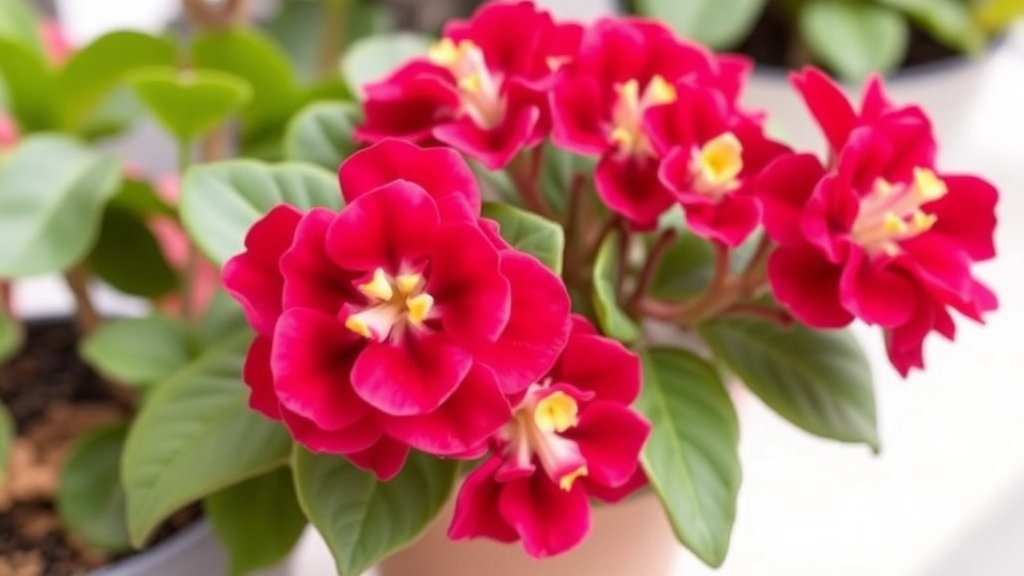Brighten Up Your Home with Kalanchoe Flaming Katy
Looking to brighten up your home with a Kalanchoe Flaming Katy houseplant? This vibrant succulent is not only eye-catching but also easy to care for. From understanding its watering needs to ensuring it gets the right amount of light, this guide will cover everything you need to know to keep your Flaming Katy thriving.
Care Requirements
Flaming Katy thrives best in bright, indirect light and well-draining soil. Overwatering is a common issue, so it’s crucial to let the soil dry out between waterings. With the right care, you can encourage your plant to re-bloom, adding a splash of colour to your indoor space year-round.
Detailed Tips
Read on for detailed tips on lighting, watering, and more to keep your Flaming Katy in top shape.
Best Conditions for Growing Flaming Katy Indoors
Are you struggling to keep your Flaming Katy thriving indoors? You’re not alone. Many plant enthusiasts face challenges when it comes to creating the ideal environment for this vibrant succulent.
To ensure your Flaming Katy flourishes, consider the following conditions:
1. Location and Space
- Bright, Indirect Light: Place your Flaming Katy near a window where it can receive bright, indirect sunlight. Too much direct sun can scorch its leaves.
- Adequate Airflow: Ensure that your plant has enough space around it for air circulation. This helps prevent mould and pests.
2. Temperature
- Ideal Range: Flaming Katy prefers a temperature range of 18°C to 24°C (65°F to 75°F). For more detailed tips, check out the ideal temperature for Kalanchoe Blossfeldiana growth.
- Avoid Cold Drafts: Keep it away from cold drafts and sudden temperature changes, as these can stress the plant.
3. Humidity Levels
- Moderate Humidity: This plant thrives in moderate humidity levels. Aim for around 40-50% humidity.
- Avoid Excess Moisture: High humidity can lead to issues like root rot, so ensure proper ventilation. Learn more about causes and solutions for brown spots on Kalanchoe leaves.
4. Container Choice
- Well-Draining Pots: Use pots with drainage holes to prevent water accumulation. Terracotta pots are an excellent choice as they allow moisture to escape.
Watering and Soil Requirements for Flaming Katy
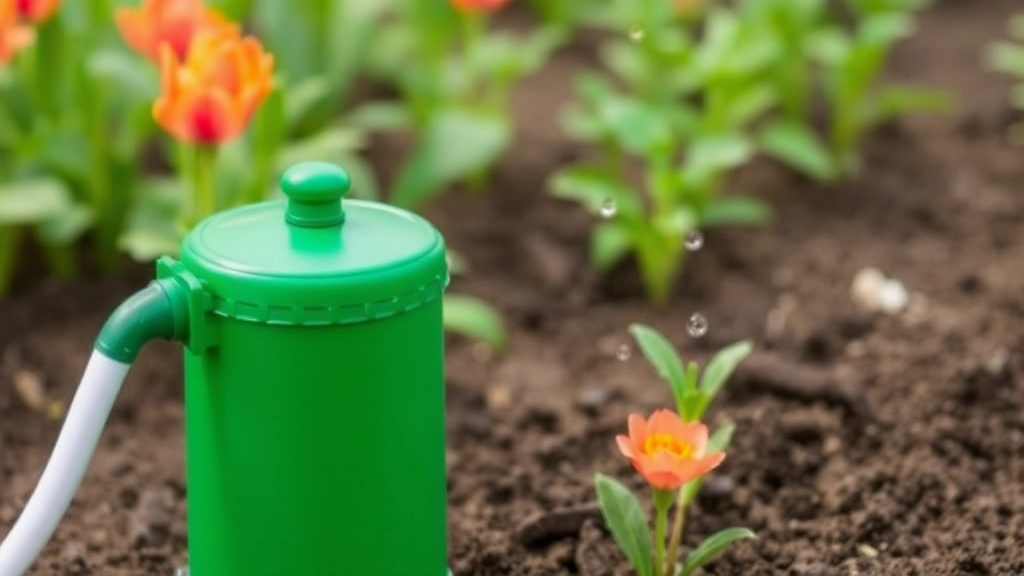
So, you’ve got your Flaming Katy, and now you’re wondering how to keep it thriving, right?
Let’s dive into the essentials of watering and soil that will make your plant happy.
Watering Your Flaming Katy
- Less is More: Flaming Katy prefers to dry out a bit between waterings. Overwatering can lead to root rot, which is a nightmare for any plant parent.
- Check the Soil: Stick your finger about an inch into the soil. If it feels dry, it’s time to water. If it’s still moist, hold off for a few days.
- Watering Technique: When you do water, do it thoroughly. Let the water drain out of the bottom of the pot. This ensures that the roots get enough moisture without sitting in water.
- Seasonal Adjustments: In the growing season (spring and summer), you might find yourself watering more frequently. In the winter, cut back a bit since the plant is in a dormant phase.
Soil Requirements
- Well-Draining Mix: The right soil is crucial. A cactus or succulent mix works wonders. You want something that drains well to prevent soggy roots.
- pH Level: Aim for a slightly acidic to neutral pH (around 6.0 to 7.0). This range keeps your Flaming Katy happy and healthy.
- DIY Soil Mix: If you’re feeling adventurous, you can make your own mix. Combine potting soil with sand or perlite to enhance drainage.
How to Avoid Common Problems: Overwatering and Root Rot
Many Flaming Katy enthusiasts face the same dilemma: how to keep their plants thriving without succumbing to the dangers of overwatering and root rot.
Understanding Overwatering
Overwatering is one of the most common issues for indoor gardeners. It can lead to root rot, which can be detrimental to your Flaming Katy’s health. Here are some key signs of overwatering:
- Yellowing Leaves: If the leaves start turning yellow, it may indicate excess moisture.
- Wilting: Surprisingly, overwatered plants can also appear wilted.
- Mushy Roots: If you inspect the roots and find them soft or mushy, it’s a clear sign of root rot.
Tips to Prevent Overwatering
To ensure your Flaming Katy remains healthy, consider these straightforward tips:
- Use Well-Draining Soil: A cactus mix or a blend that promotes drainage is ideal.
- Choose the Right Pot: Ensure your pot has drainage holes to allow excess water to escape.
- Water Sparingly: Only water when the top inch of soil feels dry. This prevents water from pooling at the roots.
- Monitor Humidity: Flaming Katy prefers lower humidity, which can help reduce the risk of overwatering.
Managing Root Rot
If you suspect your Flaming Katy has root rot, swift action is necessary. Here’s how to address it:
- Remove the Plant: Gently take the plant out of its pot.
- Inspect the Roots: Trim away any mushy or blackened roots with sterilised scissors.
- Repot: Place the plant in fresh, dry soil and a clean pot.
- Adjust Watering Schedule: After repotting, wait a week before watering again to allow the roots to recover.
By following these guidelines, you can significantly reduce the risks of overwatering and root rot, ensuring your Flaming Katy thrives indoors. For more detailed advice on why your Kalanchoe flowers might be turning brown and optimal watering tips for healthy plants, check out our other guides.
Lighting Needs for Healthy Growth and Blooming
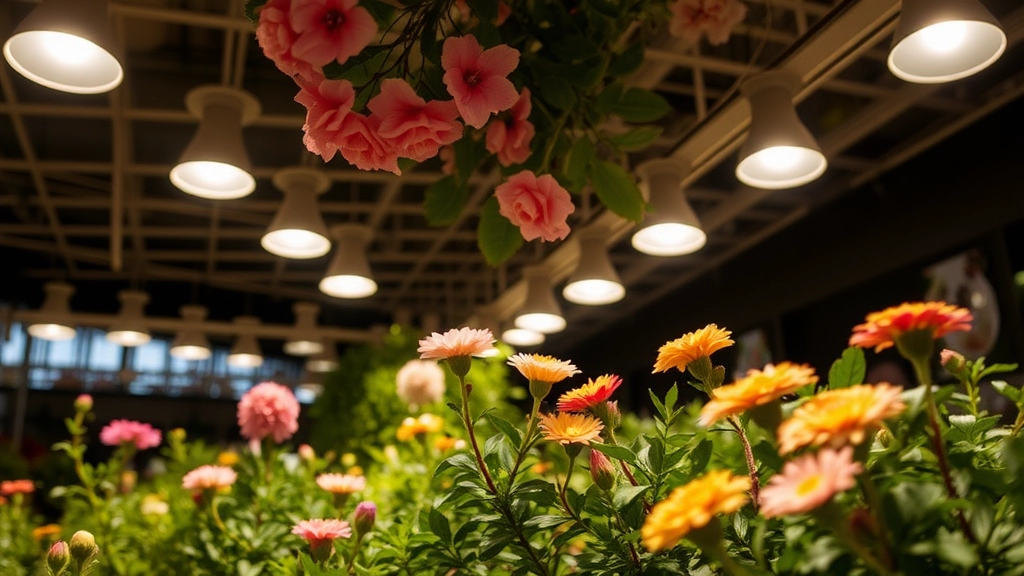
When it comes to growing Flaming Katy indoors, lighting is a crucial factor that can make or break your plant’s health and blooming potential. You may be wondering, “How much light does my Flaming Katy really need?” or “Can it thrive in low-light conditions?” Let’s dive into the specifics of lighting requirements for this vibrant succulent.
Optimal Light Conditions
Flaming Katy, or Kalanchoe blossfeldiana, thrives in bright, indirect sunlight. Here are some key points to consider:
- Direct Sunlight: While it can tolerate some direct sunlight, too much can scorch the leaves. Aim for about 4-6 hours of bright light daily.
- Artificial Lighting: If natural light is limited, consider using grow lights. LED or fluorescent lights can effectively supplement your plant’s needs.
- Rotation: To ensure even growth, rotate your Flaming Katy every few weeks. This helps all sides of the plant receive adequate light.
Signs of Inadequate Light
Understanding how your Flaming Katy responds to its lighting conditions is essential. Look out for these signs:
- Stretching: If your plant appears leggy or elongated, it may be reaching for more light.
- Fading Colour: A loss of vibrant colour in the leaves can indicate insufficient light.
- Reduced Blooming: If your plant isn’t blooming as expected, it could be a sign that it needs more light.
Seasonal Adjustments
Lighting needs can change with the seasons. During winter months, you may need to adjust the placement of your Flaming Katy to ensure it receives enough light.
- Moving Closer to Windows: Position your plant closer to south-facing windows during the shorter days of winter.
- Supplementing with Artificial Light: Consider extending light exposure with grow lights during darker months.
How to Encourage Flaming Katy to Re-Bloom
After ensuring your Flaming Katy is thriving, you may find yourself wondering how to coax it into re-blooming. It’s a common concern among plant enthusiasts, and fortunately, there are several effective strategies to encourage those vibrant flowers to return.
Key Factors for Re-Blooming
- Light Exposure:
- Ensure your Flaming Katy receives plenty of bright, indirect sunlight.
- A south-facing window is ideal, but avoid direct sunlight that can scorch the leaves.
- Watering Routine:
- Allow the soil to dry out between waterings.
- Overwatering can hinder blooming, so stick to a consistent schedule.
- Fertilisation:
- Feed your plant with a balanced fertiliser every few weeks during the growing season.
- A high-phosphorus fertiliser can be particularly effective for encouraging blooms.
- Temperature Control:
- Maintain a temperature between 15°C to 24°C.
- Sudden temperature changes can stress the plant and inhibit flowering.
- Rest Period:
- After the initial blooming period, allow your Flaming Katy to rest.
- Reduce watering and stop fertilising for about six weeks.
- Pruning:
- Trim back spent flowers and any leggy growth.
- This not only promotes new growth but also encourages the plant to focus its energy on blooming again.
- Pest Management:
- Regularly check for pests that can sap your plant’s energy.
- Treat any infestations promptly to keep your Flaming Katy healthy.
By following these tips, you can significantly increase the chances of your Flaming Katy blooming again, bringing a splash of colour back into your indoor space. For more detailed guidance, check out our Flaming Katy care guide and learn how to deadhead Kalanchoe flowers for continuous blooming.
Tips for Pruning and Deadheading to Prolong Blooming
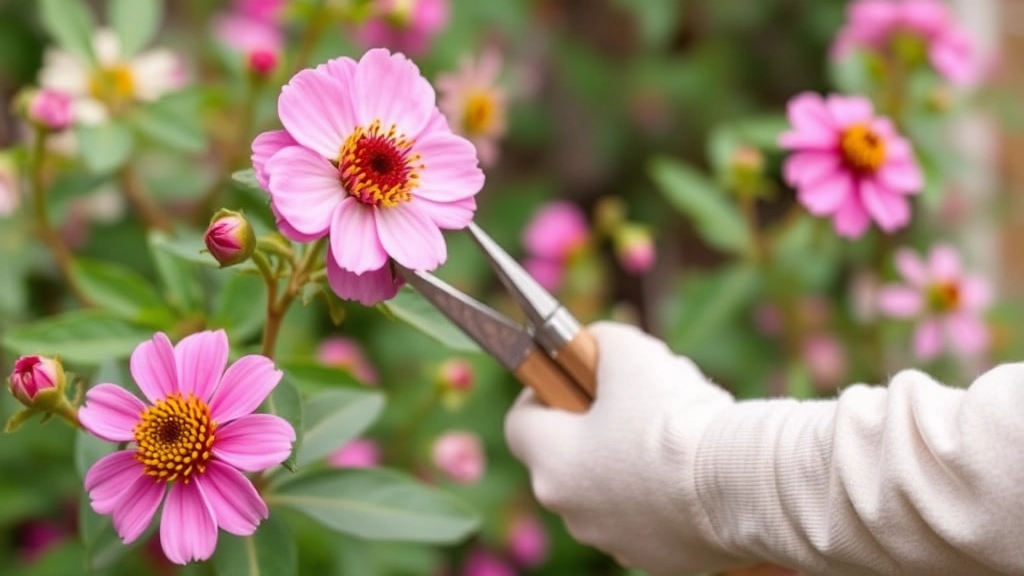
So, you want to keep your Flaming Katy blooming for as long as possible? Pruning and deadheading are your best friends here.
Why Pruning Matters
Pruning isn’t just about making your plant look tidy. It’s essential for encouraging new growth and, ultimately, more blooms.
Deadheading Basics
Deadheading is the process of removing spent flowers. Here’s how to do it right:
- Use Clean Tools: Always grab a pair of sharp, clean scissors or pruning shears. This helps prevent any infections.
- Cut Just Above the Leaf Node: When you snip off a spent flower, cut just above where the leaves meet the stem. This encourages new growth.
- Don’t Be Shy: If a stem looks leggy or unhealthy, don’t hesitate to prune it back. Your Flaming Katy will thank you!
When to Prune
Timing is everything. Here’s a quick guide:
- After Blooming: Once your Flaming Katy has finished its flowering cycle, that’s the perfect time to prune.
- Regular Maintenance: A light trim every few weeks can keep your plant looking fresh.
Pro Tip: Always keep an eye on your plant. If you notice any yellowing leaves or dead flowers, take action immediately.
Propagation Techniques for Flaming Katy
When it comes to expanding your collection of Flaming Katy, or Kalanchoe blossfeldiana, propagation is an exciting and rewarding process. You may be wondering how to successfully propagate this vibrant succulent.
Methods of Propagation
- Leaf Cuttings
- Select a healthy leaf from the parent plant.
- Allow the cut end to callous over for a few hours or overnight.
- Plant the leaf in well-draining soil, burying the cut end slightly.
- Water sparingly until new growth appears.
- Stem Cuttings
- Cut a healthy stem, ideally 4-6 inches long, just below a leaf node.
- Remove the lower leaves to expose the stem.
- Let the cut end callous for a few hours.
- Place the stem in a pot with cactus mix or well-draining soil.
- Water lightly and keep in a warm, bright location.
- Offsets
- Look for small offsets or pups at the base of the parent plant.
- Gently separate the offset from the main plant.
- Allow the cut surface to dry for a few hours.
- Plant the offset in a suitable potting mix and water lightly.
Tips for Successful Propagation
- Ensure your tools are clean to prevent disease.
- Use a pot with drainage holes to avoid waterlogging.
- Keep the newly propagated plants in indirect sunlight until they establish roots.
Propagation not only allows you to create new plants but also helps rejuvenate the parent plant, promoting healthier growth. For more detailed guidance, check out our step-by-step guide on propagating Kalanchoe Mother of Thousands. Additionally, if you’re interested in learning about different Kalanchoe varieties, our guide on Kalanchoe Tomentosa varieties is a must-read.
Common Pests and How to Treat Them
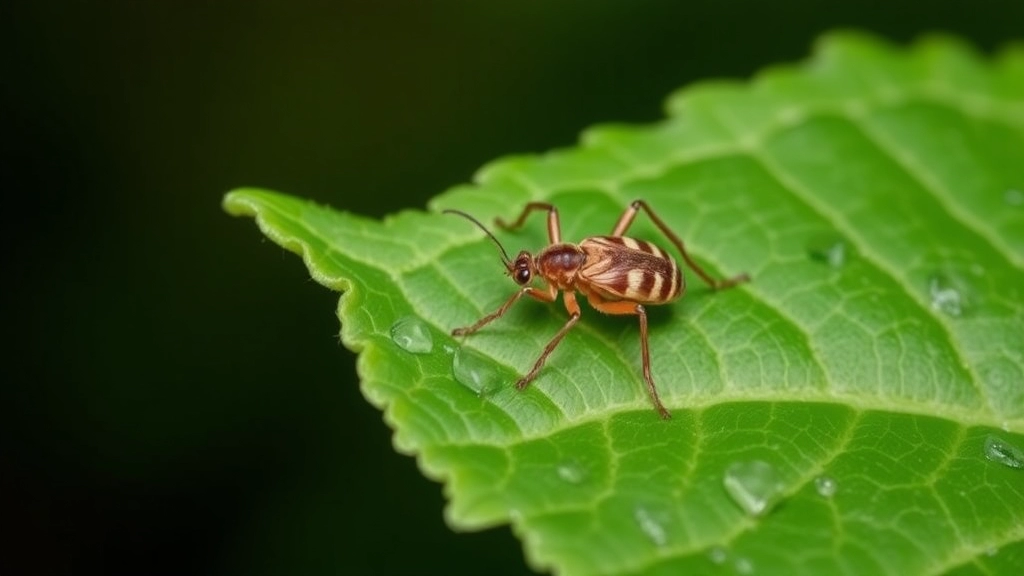
So, you’ve got your Flaming Katy thriving, but what happens when those pesky pests come knocking?
It’s a real concern for many plant parents, and trust me, I’ve been there.
Common Pests to Watch For:
- Mealybugs
- Look like tiny cottony clumps on leaves.
- They suck the sap, weakening your plant.
- Aphids
- Small, green or black insects.
- They can distort new growth and leave a sticky residue.
- Spider Mites
- Tiny and hard to see, but you might notice fine webbing.
- They thrive in dry conditions, sucking moisture from leaves.
- Scale Insects
- Brown, shell-like bumps on stems and leaves.
- They can be tough to spot but can cause serious damage.
How to Treat These Pests:
- Regular Inspection
- Check your plants weekly for any signs of pests.
- Early detection is key to keeping your Flaming Katy healthy.
- Natural Remedies
- Neem Oil: A natural pesticide that works wonders. Mix it with water and spray on affected areas.
- Insecticidal Soap: Safe for indoor plants. Spray it directly on the pests.
- Isolation
- If you spot pests, isolate the affected plant to prevent spreading.
- This gives you time to treat it without risking your other plants.
- Physical Removal
- For mealybugs and scale, use a cotton swab dipped in alcohol to wipe them off.
- This can be a bit tedious but is super effective.
- Maintain Healthy Conditions
- Keep your Flaming Katy in optimal conditions.
- A healthy plant is less likely to attract pests.
Temperature and Humidity Preferences for Optimal Health
When caring for your Flaming Katy, understanding its temperature and humidity preferences is crucial for fostering a thriving indoor environment.
Ideal Temperature Range
Flaming Katy, also known as Kalanchoe blossfeldiana, flourishes best in a warm environment. Here are some key points to consider:
- Daytime Temperature: Aim for a range of 20°C to 24°C (68°F to 75°F).
- Nighttime Temperature: A cooler range of 15°C to 18°C (59°F to 64°F) is ideal during the night.
This temperature fluctuation mimics its natural habitat and encourages healthy growth.
Humidity Levels
Flaming Katy prefers moderate humidity levels.
- Optimal Humidity: Aim for 40% to 60% humidity.
- Avoid Excess Moisture: Too much humidity can lead to fungal issues, while too little can cause leaf drop.
To maintain proper humidity, consider using a humidity tray or misting occasionally, especially in drier months.
Tips for Maintaining Ideal Conditions
- Location: Place your Flaming Katy away from drafty windows or heating vents.
- Temperature Monitoring: Use a thermometer to keep track of indoor temperatures.
- Humidity Control: If your home is particularly dry, a humidifier can help maintain the right levels.
By ensuring your Flaming Katy is in the right temperature and humidity zone, you set the stage for vibrant blooms and healthy foliage. For more detailed care instructions, check out our complete care guide for Kalanchoe Flaming Katy houseplant.
If you’re interested in exploring other Kalanchoe varieties, consider reading our top Kalanchoe succulent varieties and care tips to find the perfect plant for your home.
FAQs for Kalanchoe Flaming Katy Houseplant
How often should I water my Flaming Katy?
Less is more when it comes to watering your Flaming Katy. Allow the soil to dry out a bit between waterings. Stick your finger about an inch into the soil; if it feels dry, it’s time to water. Overwatering can lead to root rot.
What type of soil is best for Flaming Katy?
A well-draining soil mix is crucial. A cactus or succulent mix works wonders. You can also make your own by combining potting soil with sand or perlite to enhance drainage. Aim for a slightly acidic to neutral pH (around 6.0 to 7.0).
How much light does Flaming Katy need?
Flaming Katy thrives in bright, indirect sunlight. Aim for about 4-6 hours of bright light daily. If natural light is limited, consider using grow lights. Rotate your plant every few weeks to ensure even growth.
Can Flaming Katy survive in low-light conditions?
While Flaming Katy prefers bright light, it can tolerate lower light conditions. However, inadequate light may lead to leggy growth, fading color, and reduced blooming.
How do I prune and deadhead my Flaming Katy?
Pruning and deadheading are essential for encouraging new growth and prolonging blooming. Use clean, sharp scissors or pruning shears to cut just above the leaf node. Regular maintenance every few weeks can keep your plant looking fresh.
What are common pests that affect Flaming Katy?
Common pests include mealybugs, aphids, spider mites, and scale insects. Regular inspection, natural remedies like neem oil or insecticidal soap, and maintaining healthy conditions can help keep these pests at bay.
How do I treat pests on my Flaming Katy?
For mealybugs and scale, use a cotton swab dipped in alcohol to wipe them off. Natural remedies such as neem oil or insecticidal soap are effective. Isolate the affected plant to prevent spreading and keep it in optimal conditions to reduce pest attraction.
Should I adjust care routines seasonally for Flaming Katy?
Yes, seasonal adjustments are crucial. During the growing season (spring and summer), you might water more frequently. In winter, reduce watering as the plant enters a dormant phase. Also, adjust lighting by moving the plant closer to windows or using grow lights during shorter days.
What are signs that my Flaming Katy needs more light?
Look for signs such as stretching (leggy growth), fading color, and reduced blooming. These indicate that your plant may need more light.
Can I make my own soil mix for Flaming Katy?
Absolutely! Combine potting soil with sand or perlite to enhance drainage. This DIY mix can provide the well-draining conditions that Flaming Katy prefers.
References
-
The Spruce: How to Grow and Care for Flaming Katy
-
Gardening Know How: Kalanchoe Care – How to Grow Kalanchoe Plants
-
House Plants Expert: Flaming Katy (Kalanchoe blossfeldiana)
